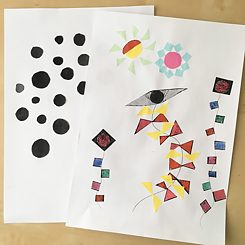Colour, Form, Painting
Module 8
School // Workshop
Age 12–15 // 2 hours // 3 lessons
Painting // collage
Theory of colour // theory of form // Wassily Kandinsky // Paul Klee
 Silke Wittig | CC BY-NC-SA 4.0
YOU WILL NEED:
Silke Wittig | CC BY-NC-SA 4.0
YOU WILL NEED:
- A4 paper
- A3 paper
- coloured paper
- coloured pencils
- watercolours
- scissors
- glue sticks
- colour copies of paintings by Wassily Kandinsky and Paul Klee
INSTRUCTIONS
In this module participants learn about the theory of form and colour, and about the painting of the famous artists, Bauhaus masters and pioneers of abstract art, Wassily Kandinsky and Paul Klee. First they view selected works by the two artists and investigate the effect and expression of colour and form. Then they produce their own interpretations using techniques of painting and collage.Step 1: The group examines paintings by Kandinsky and Klee. Participants describe what they see and what figures they can discover. There are no limits to the imagination here.
Step 2: In the next step special attention is paid to colours, lines and basic geometrical forms. Which elements appear? How are they combined with one another? Can the paintings be completely reduced to geometrical forms (circles, triangles, squares and rectangles)?
Step 3: Now colour copies of the paintings are distributed and the participants cut out the geometrical forms. They rearrange these to make their own collages, combining elements from different paintings and using coloured pencils and watercolours to create their own figures. Additional geometrical forms can be cut out of coloured paper and included in the collages.
Step 4: Finally the pictures are displayed on the wall and viewed by the group. What effect do the colours have? What new formations are created by the geometrical forms? What might the next stage of abstraction look like?



